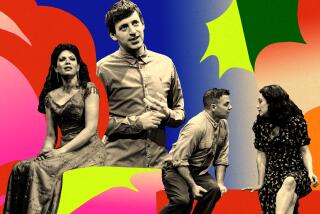Why ‘Hadestown’ deserves the Tony Award for best musical of the year
It turned out not to be a horrendous year for new Broadway musicals, if you disqualify “King Kong,” lower your IQ for “The Cher Show” and bring earplugs to “Be More Chill.”
“The Prom,” a campy musical about Broadway troupers on a social justice mission in the Midwest, was giddy fun until it went fishing for genuine feeling and reeled in earnest predictability. “Ain’t Too Proud — The Life and Times of the Temptations,” which I caught at the Ahmanson last summer on its groove train to New York, made up in showmanship what it lacked in behind-the-hits drama.
“Tootsie,” the rare musical that’s as clever as its movie source, could give “The Book of Mormon” a run for its guffaws. I didn’t make it to “Beetlejuice,” because life is short and hotels are expensive, but director Alex Timbers can always be counted on for quirky color.
These four Tony-nominated musicals would seem to make a perfectly respectable crop. But the show that redeemed the year for me is “Hadestown,” which gracefully extends the unexpected pathway of the last four best musical winners: “Fun Home,” “Hamilton,” “Dear Evan Hansen” and “The Band’s Visit.” Nominated for 14 Tony Awards, the most of any production, “Hadestown” should, if there’s any justice in the Broadway universe, take home the evening’s top prize.
Based on the 2010 concept album by Anaïs Mitchell, this folk opera with a New Orleans soul is quite simply one of the most exquisite works of musical storytelling I’ve seen in my more than 25 years as a theater critic. Directed by Rachel Chavkin with all the ingenuity she brought to her previous Broadway game-changer, “Natasha, Pierre, & the Great Comet of 1812,” the production harmonizes its elements into a Wagnerian dream of a total artwork.
‘WHAT THE CONSTITUTION MEANS TO ME’: Why Heidi Schreck is revising her play after Broadway »
Emily Dickinson once observed that “remorse for the brevity of a Book is a rare emotion.” These words sometimes come back to me as I glance at my watch during a show that can’t figure out how to pull itself together. The storytelling in “Hadestown” occasionally sputters, but I never wanted the evening to end — if only to bask in the perfect marriage of music and scenic motion.
As entrancingly mercurial as the score, Chavkin’s staging casts a spell that liberates us from earthly time. An interweaving of two myths about lovers, Orpheus (Reeve Carney) and Eurydice (Eva Noblezada) and Hades (Patrick Page) and Persephone (Amber Gray), the show invites us to take part in a sacred ritual, a collective retracing of archetypal patterns.
ALSO: Tony nominations led by ‘Hadestown,’ ‘Ain’t Too Proud’ and ‘Tootsie’ »
For those needing a refresher on their ancient legends, Orpheus, who can enchant even stones with his lyre and singing voice, fell in love with Eurydice, who was bitten by a snake on their wedding day, causing Orpheus to try to rescue her from the underworld. Hades, god of the dead, abducted Persephone, whose mother (goddess of the harvest) wielded her powers to ensure that her daughter would at least be able to return to Earth for half the year, leaving the other months in gray barrenness.
No, love doesn’t have an easy time in the ancient world. In Mitchell’s contemporary reworking, Page’s Hades gives off a predatory chill with his Leonard Cohen-esque rumbling. Gray’s Persephone has the sultry, somewhat strung-out air of a jazz diva who can still access her heart beneath the weary cynicism. Carney’s Orpheus and Noblezada’s Eurydice are like shell-shocked millennials still shaking their heads at the world they inherited.
But the originality of the musical goes beyond its mythic update. Ranging freely across disciplines, “Hadestown” braids influences from across the artistic spectrum.
The moonlit music occasionally evokes “Spring Awakening” in its moody choral moments. The presence of a slick narrative preacher-guide, André De Shields summoning all his feline elegance in the role of Hermes, rapturously brings back Lee Breuer and Bob Telson’s “The Gospel at Colonus.” And the flair with which ancient myth is dispersed across its medium recalls the cross-cultural cinematic swirl of Marcel Camus’ 1959 film, “Black Orpheus.”
A cabaret tapestry unfolding with dreamlike freedom, the musical has been faulted for its patches of narrative fuzziness. Some have complained that the young lovers, Orpheus and Eurydice, aren’t compelling as central characters and that they are given less texture than Hades and Persephone, whose parallel subplot steals the show.
This folk opera with a New Orleans soul is one of the most exquisite works of musical storytelling I’ve seen in my more than 25 years as a theater critic.
I have a different take on “Hadestown,” which isn’t a book musical in the traditional sense. Mitchell, who wrote the show, finds integration through the music. The narrative is subsumed in the score. And the genius of the work — what transforms it from a concept album to a full-fledged theatrical musical — is how the sound is scenically animated.
A certain distance from characters is par for the course in archetypal material. Are we meant, for instance, to psychologically doubt the way Romeo capriciously falls head over heels for Juliet after the way he’s been pining away for Rosaline? The truth resides in the outline. The details of Orpheus and Eurydice’s courtship aren’t as important as the universal rhythms of their attachment. Not every work has to stand the test of realism to convey reality.
Chavkin, whose direction is part of the authorship of “Hadestown,” foregrounds the ensemble nature of the musical. Hermes mediates the tale; Persephone and Hades extend and complicate it. A chorus of Fates reflects on the goings-on like whispering inner voices and an onstage band provides waves of music for all to ride on.
The audience, too, is implicated, as it is for us that these tragic old stories are being resurrected in new clothes. There is no fourth wall. The barrier between the stage and the audience is lifted even as we look on in awe. This is theater as rollicking church. (Praise Dionysus!) “It’s an old song/And we’re gonna sing it again,” intones Hermes with evangelical fervor in the opening number. Passive viewership is not an available option.
“Hadestown” has been evolving since receiving its world premiere at New York Theatre Workshop in 2016. A production at London’s National Theatre prepared the way for Broadway, where I finally encountered the show at the Walter Kerr Theatre.
I can’t wait to lose myself again in laughter when “Toostie” goes on tour. And I look forward to spending more time with the hilariously hapless Broadway rescue squad of “The Prom.” But in its supple convergence of story and song, “Hadestown” represents a step forward for the art form.
Chavkin paints with Mitchell’s palette, integrating the author-composer’s colors with those of her seamless company. David Neumann’s choreography blurs the distinction between dance and gesture with neo-Fosse nonchalance. Carney, Noblezada, De Shields, Page and Gray are as distinctive as musical instruments in a small orchestra. The luminous design team has earned its raft of Tony nominations in a production that scenically never misses a beat.
If I seem love-struck, there’s a reason: In its trip down to hell, “Hadestown” is the one show that transported this Broadway theatergoer to heaven.
TONY AWARDS: Why ‘Constitution’ and not ‘The Ferryman’ should win best play »
More to Read
The biggest entertainment stories
Get our big stories about Hollywood, film, television, music, arts, culture and more right in your inbox as soon as they publish.
You may occasionally receive promotional content from the Los Angeles Times.







